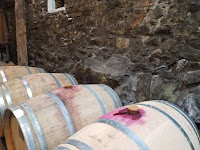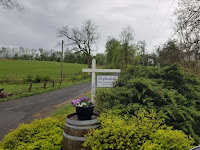
This month I received two ciders from New York's
Seminary Hill Orchard & Cidery as part of the BevFluence
New Perspectives on Cider campaign. Seminary Hill is located in the western Catskills, specifically in Callicoon, a small town on the Delaware River that separates New York and Pennsylvania. It is owned by Chicagoans Doug Doetsch and Susan Manning although Doetsch's pedigree in the region extends back multiple generations. The property is named after a Romanesque-style seminary that Franciscan priests built in 1901. Besides the cider house, which utilizes wood reclaimed from the now-demolished Tappan Zee Bridge, the property includes a Boarding House that occupies a former hospital and doctor's office.

Through the assistance of architect James Hartford and River Architects, Seminary Hill is the world's first
Passive House certified alcoholic beverage facility. Many people are more familiar with the LEED sustainable building certification, but the Passive House certification identifies "a handful of practices that have the biggest effect. This makes it simpler for more people to get involved in making sustainable buildings and thus increases the cumulative effect. Through computer modeling, it was determined that the key elements were a super-tight envelope, with all air exchange going through an energy recovery ventilator; high levels of insulation; and solar orientation and shading to gain solar heat in the winter and reject it in the summer."
Although Seminary Hill is a relatively new operation, they utilize the services of long-time cider-maker Stuart Madany. I first encountered Stuart 11 years ago when he was the cidermaker at Castle Hill Cider in central Virginia and introduced us to cider aged in Georgian Kevri. See Winemaker Series: Castle Hill Cider & Kvevri. Through email, he was able to explain some of the differences and similarities between cider-making in New York State and Central Virginia:
Both New York State and Central Virginia have pretty well-developed tasting room cultures - so to speak. People like to go and spend time tasting various craft beverages and visiting the places they're made. I think Harvest-Driven cider is probably a little more prevalent and a little more broadly appreciated in New York.
Certainly, the soil is different with the tremendous amount of rock and ledge here. My first week here someone told me that the gardeners here have a saying, that there are two rocks here for every dirt. There's a good bit of clay here too, but not as red as the heavy clay of Central Virginia.
And of course, the growing season is shorter, with colder, and snowier winters.
For me, the big difference this translates into is which varieties really shine in the cider. We're not growing Black Twig here, and the GoldRush I've found to be underwhelming. But, there are extremely exciting bittersweets and aromatic apples up here. While Harry Master's Jersey, or Tremlett's Bitter might give you a bit of aroma along with their high tannin in Virginia, they can be bursting with aroma and flavor up here. The French Amere de Bethencourt has some fantastic exotic spiciness. Aromatic apples like Ribston Pippin and Egremont Russet are also just packed with aroma and wonderful to work with. I'm hoping to have more apples of these varieties to work with this fall.

For the BevFluence tasting, we received two ciders representing the breadth of the Seminary Hill Orchard. The
Delaware Dry 2020 is a bone-dry blend of Chisel Jersey (bittersharp) 42%, Baldwin (sharp-sweet) 26%, Golden Russet (sharp) 20%, and Northern Spy (sharp-sweet) 12%. Slightly sweeter, the
Cackling Hen 2021 is a semi-sweet blend of Dabinett (bittersweet) 35%, Wickson (sweet) 19%, Newtown Pippin (sharp) 15%, Chisel Jersey (bittersharp) 8%, Golden Russet (sharp) 7%, GoldRush (sharp) 4%, Harry Master's Jersey (bittersweet ) 4%, Puget Spice (bittersharp) 2%, and others 6%. See the LARS classification below for what each apple variety contributes to the blend.
Because the orchard is so young and there are very few cider apple growers in the area, Seminary Hill decided to plant as many varieties as possible in order to determine which are most suitable for Sullivan County in terms of both harvest size and flavor. In total, Seminary Hill's orchard contains 54 apple varieties and 7 perry pear varieties. This explains the large number of apple varieties in each of these ciders but obscures the number of blending and small-batch trials used to create each composition. According to Madany, "Eventually, it will mean that our blends reflect the best of the potential of our spot on earth".
Being a new orchard, Seminary Hill is working through its pest management regime, particularly being an organic cidery. Fire blight is a contagious bacterial disease that can only be prevented and is becoming more of a problem in New York over the last couple of yours. Infected trees must have the fire blight 'strikes' cut out after infection. Cooler weather, particularly through the bloom season, helps contain this bacteria.
The labels of the two ciders also reflect the history and geography of the region -- obviously
Delaware Dry for the river. Dutch hunters tracked beaver along the Delaware River during the 1600s and the town of Callicoon is based on the Dutch "Kollikoon" which means: wild turkeys. Thus
Cackling Hen references both the town and wild turkeys -- which are still abundant today.
On the palate, the Delaware Dry contains a tasteful, fleshy, and chewy distribution of tannins and acidity There are also noticeable malic qualities providing a long and clean finish. The Cackling Hen has a stronger nose and is more tart and tannic which I think the sugar and fleshy apple flavors help control. I added a little Sagebird Cider Pommeau which accentuates the acidity while tamping down the tannins, and without adding much additional sweetness.
LARS Classification:
Sweet (low acid, low tannin)
Sharp (high acid, low tannin)
Bittersweet (low acid, high tannin)
Bittersharp (high acid, high tannin)
 During 2022 we visited a little less than 70 craft beverage establishments, a paltry figure which is embarrassing for an entity that professes to publicize the craft beverage industry. And we created theCompass Craft Beverage Finder specifically for individuals to find these establishments anywhere in North America. We initially vowed to get to at least 100 in 2023, which was further increased to 200 after a quick start to this endeavor. And at the end of June, we visited our 100th craft beverage establishment in 2023: Box Office Brewery.
During 2022 we visited a little less than 70 craft beverage establishments, a paltry figure which is embarrassing for an entity that professes to publicize the craft beverage industry. And we created theCompass Craft Beverage Finder specifically for individuals to find these establishments anywhere in North America. We initially vowed to get to at least 100 in 2023, which was further increased to 200 after a quick start to this endeavor. And at the end of June, we visited our 100th craft beverage establishment in 2023: Box Office Brewery. This was my second visit to this Shenandoah Valley brewery located inside the historic Strand Theatre in Strasburg, Virginia. The theatre was originally built in 1918 and Box Office utilizes several historical items such as a 1930s Lucky Strike bowling lane for the main bar. As they offer a pentagon of tastings in a flight, visitors can obtain a reasonable representation of their beer offerings. For your flight, I would recommend the Old Valley Pike American Pale Ale, Prohibition Pilsner, Signal Knob IPA, Massanutty Brown Ale, and Curtain Call Coconut Porter. And ask your server about the history behind each beer name.
This was my second visit to this Shenandoah Valley brewery located inside the historic Strand Theatre in Strasburg, Virginia. The theatre was originally built in 1918 and Box Office utilizes several historical items such as a 1930s Lucky Strike bowling lane for the main bar. As they offer a pentagon of tastings in a flight, visitors can obtain a reasonable representation of their beer offerings. For your flight, I would recommend the Old Valley Pike American Pale Ale, Prohibition Pilsner, Signal Knob IPA, Massanutty Brown Ale, and Curtain Call Coconut Porter. And ask your server about the history behind each beer name. 















































